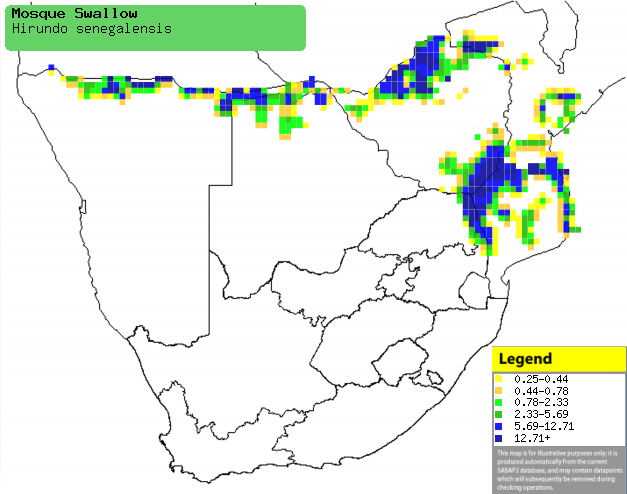|
Hirundo senegalensis (Mosque
swallow)
Moskeeswael [Afrikaans]; Sisampamema (generic term for
swallows, martins, swifts and spinetails) [Kwangali]; Nyengha (generic term for
swallow) [Tsonga]; Moskeezwaluw [Dutch]; Hirondelle des mosquées [French];
Senegalschwalbe [German]; Andorinha-das-mesquitas [Portuguese]
Life
> Eukaryotes >
Opisthokonta
> Metazoa (animals) >
Bilateria >
Deuterostomia > Chordata >
Craniata > Vertebrata (vertebrates) > Gnathostomata (jawed
vertebrates) > Teleostomi (teleost fish) > Osteichthyes (bony fish) > Class:
Sarcopterygii (lobe-finned
fish) > Stegocephalia (terrestrial
vertebrates) > Tetrapoda
(four-legged vertebrates) > Reptiliomorpha > Amniota >
Reptilia (reptiles) >
Romeriida > Diapsida > Archosauromorpha > Archosauria >
Dinosauria
(dinosaurs) > Saurischia > Theropoda (bipedal predatory dinosaurs) >
Coelurosauria > Maniraptora > Aves
(birds) >
Order: Passeriformes > Family: Hirundinidae
Distribution and habitat
Patchily distributed across sub-Saharan Africa, from
Senegal to Ethiopia south to southern Africa. Here it is scarce in the extreme
north of Namibia, Botswana and Zimbabwe, with a separate population east of
Limpopo Province and Mpumalanga, south-eastern Zimbabwe and southern and central
Mozambique. It generally prefers dense broad-leaved woodland, especially Mopane
(Colosphermum mopane) but also Miombo (Brachystegia), with
scattered baobabs (Adansonia digitata) and leadwoods (Combretum
imberbe).
|
 |
|
Distribution of Mosque swallow in southern Africa,
based on statistical smoothing of the records from first SA Bird Atlas
Project (©
Animal Demography unit, University of
Cape Town; smoothing by Birgit Erni and Francesca Little). Colours range
from dark blue (most common) through to yellow (least common).
See here for the latest distribution
from the SABAP2. |
Movements and migrations
Mostly resident in southern Africa, but
partially migratory in northern Namibia and Botswana, where a lot of
the population leave during winter.
Food
It eats flying insects, such as ants, termites and flies,
typically foraging 20-30 metres above ground. It also attends termite emergences
and fires, sometimes gathering in flocks of up to 100 birds.
Breeding
- Monogamous, nesting either solitarily or in small groups.
- The nest is a gourd-shaped bowl built of mud pellets and lined with
grass and feathers, with a long entrance tunnel attached to the side. It is
often placed in tree cavities (especially in Baobab Ansonia digitata),
alternatively in or under tree branches, in buildings or road culverts.
- Egg-laying season is year-round, peaking from August-April.
- In Uganda it lays 2-4 pure white eggs.
Threats
Not threatened, in fact its range has expanded recently
into the Skukuza region of the Kruger National Park.
References
-
Hockey PAR, Dean WRJ and Ryan PG 2005. Roberts
- Birds of southern Africa, VIIth ed. The Trustees of the John Voelcker
Bird Book Fund, Cape Town.
-
Harrison, J.A., Allan, D.G., Underhill, L.G., Herremans, M.,
Tree. A.J., Parker, V. & Brown, C.J. (eds). 1997. The atlas of southern
African birds. Vol. 2: Passerines. BirdLife South Africa, Johannesburg.
|
